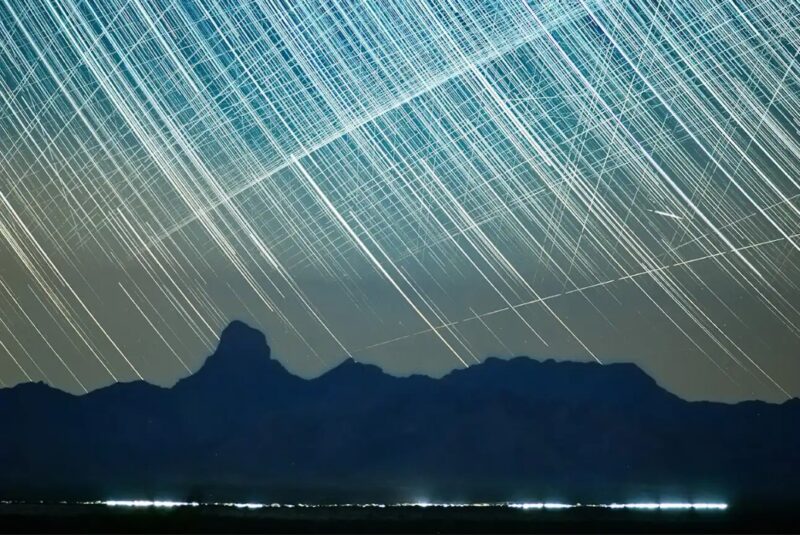Satellite trails crisscross the night
John Ashley in southern Arizona emailed a timelapse video to EarthSky this week, showing Comet 13P/Olbers crossing the sky. But even more noticeable are the “tons of satellite trails,” as John said. The onslaught of satellites makes it difficult to concentrate on the fuzzy solar system visitor passing Earth. Also, see if you can spot the two airplanes in the video. Here’s what John told EarthSky about making the video:
We have at least a week of monsoon clouds in the forecast here in southern Arizona. So on the night of July 9, I drove over to Buenos Aires National Wildlife Refuge to see if I could find Comet 13P/Olbers through the thin layer of local haze and wildfire smoke (from Utah). It was 100 F (37.7 C) at sunset, partly cloudy, with a bit of illumination from a 17% crescent moon when I started this timelapse at 8:53 p.m.
I scanned all evening with binoculars, but was unable to see the comet with my eyes. Atmospheric extinction along the western horizon was pretty bad, with most of the stars also disappearing before reaching the mountains.
The satellites above the haze, however, were easily visible to my eyes. The composite image at the end of the video only includes 45 minutes’ worth of images when the comet was in the frame (9:45 p.m. to 10:30 p.m.). Curving lines angling down are stars, straight lines angling up are satellites, and the comet trail is barely visible if you know exactly where to look.
Are satellites ruining the night sky?
The issue of satellites is hotly debated among astronomers. Here’s what John had to say about this modern form of light pollution.
I’ve been a dark sky advocate for a decade now, giving many public programs. And I’ve found that preaching doesn’t really work. So now I just try to show people examples of light pollution, and they’ll decide if it’s important enough to address somehow in their own lives. A lot of these satellites are useful to us all. I rely on some of them for weather, climate change and light pollution data. So it’s not like they are going away anytime soon. It’s just sad to see the crazy proliferation, and I miss the days when ‘spot the satellite’ was fun.

Bottom line: John Ashley captured satellite trails crisscrossing the Arizona night sky on July 9, 2024, while attempting to capture Comet 13P/Olbers. Watch his video here.
The post Satellite trails – and a comet – crisscross Arizona sky first appeared on EarthSky.
from EarthSky https://ift.tt/XeGJjFh
Satellite trails crisscross the night
John Ashley in southern Arizona emailed a timelapse video to EarthSky this week, showing Comet 13P/Olbers crossing the sky. But even more noticeable are the “tons of satellite trails,” as John said. The onslaught of satellites makes it difficult to concentrate on the fuzzy solar system visitor passing Earth. Also, see if you can spot the two airplanes in the video. Here’s what John told EarthSky about making the video:
We have at least a week of monsoon clouds in the forecast here in southern Arizona. So on the night of July 9, I drove over to Buenos Aires National Wildlife Refuge to see if I could find Comet 13P/Olbers through the thin layer of local haze and wildfire smoke (from Utah). It was 100 F (37.7 C) at sunset, partly cloudy, with a bit of illumination from a 17% crescent moon when I started this timelapse at 8:53 p.m.
I scanned all evening with binoculars, but was unable to see the comet with my eyes. Atmospheric extinction along the western horizon was pretty bad, with most of the stars also disappearing before reaching the mountains.
The satellites above the haze, however, were easily visible to my eyes. The composite image at the end of the video only includes 45 minutes’ worth of images when the comet was in the frame (9:45 p.m. to 10:30 p.m.). Curving lines angling down are stars, straight lines angling up are satellites, and the comet trail is barely visible if you know exactly where to look.
Are satellites ruining the night sky?
The issue of satellites is hotly debated among astronomers. Here’s what John had to say about this modern form of light pollution.
I’ve been a dark sky advocate for a decade now, giving many public programs. And I’ve found that preaching doesn’t really work. So now I just try to show people examples of light pollution, and they’ll decide if it’s important enough to address somehow in their own lives. A lot of these satellites are useful to us all. I rely on some of them for weather, climate change and light pollution data. So it’s not like they are going away anytime soon. It’s just sad to see the crazy proliferation, and I miss the days when ‘spot the satellite’ was fun.

Bottom line: John Ashley captured satellite trails crisscrossing the Arizona night sky on July 9, 2024, while attempting to capture Comet 13P/Olbers. Watch his video here.
The post Satellite trails – and a comet – crisscross Arizona sky first appeared on EarthSky.
from EarthSky https://ift.tt/XeGJjFh

Aucun commentaire:
Enregistrer un commentaire